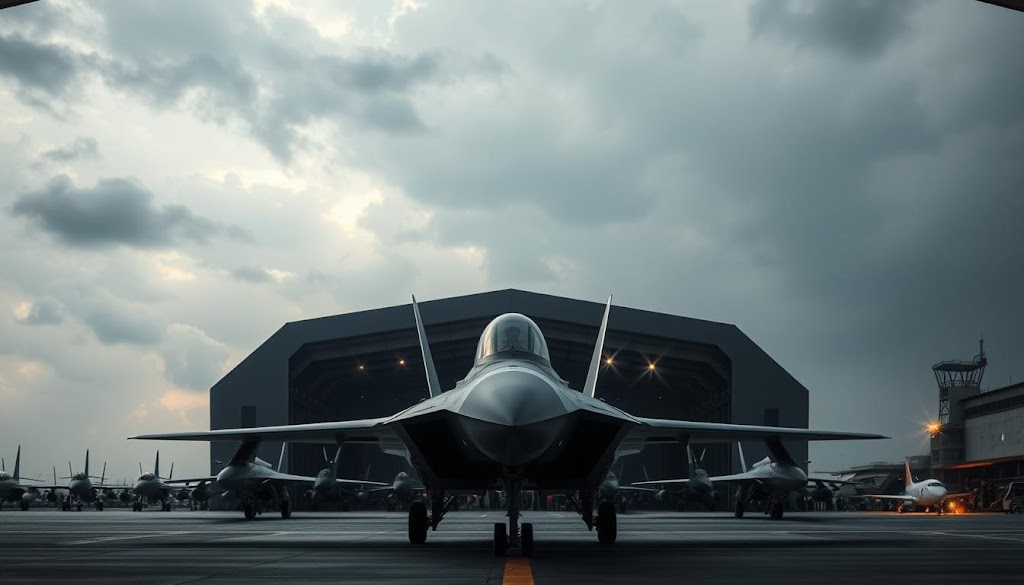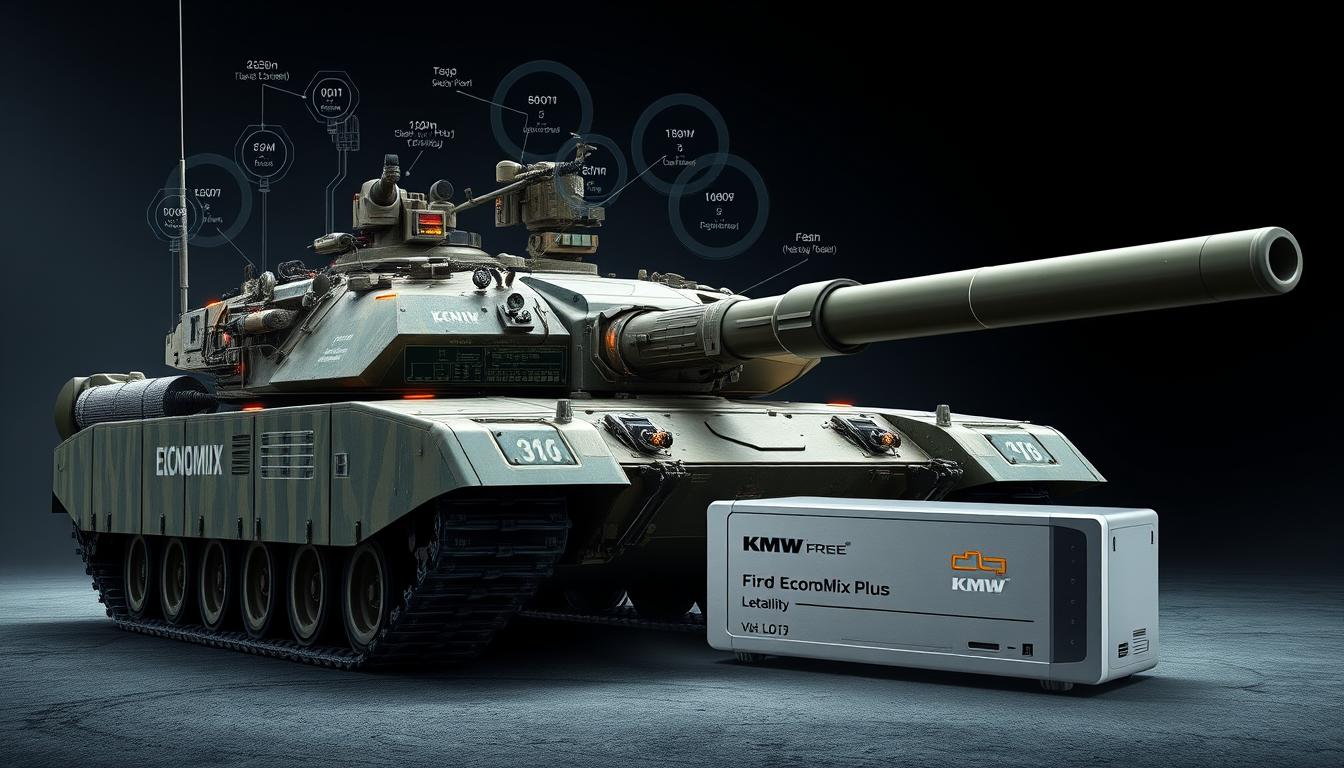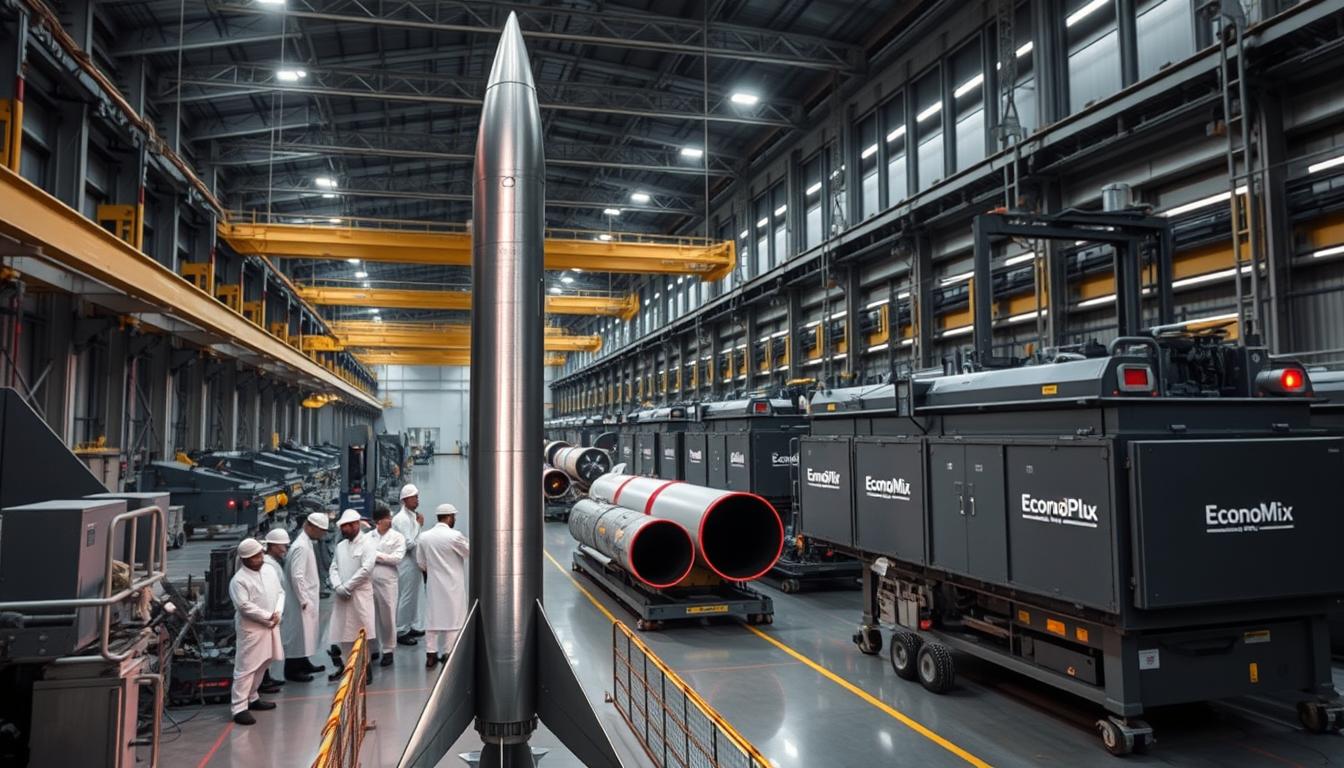As the world of military aviation changes, a big question pops up: Can China’s aerospace industry, led by AVIC, challenge the dominance of traditional Western defense giants?
The rise of AVIC in the China military aviation market is something we need to look into. AVIC’s growth is linked to China’s efforts to modernize its military and its growing role in global defense markets.
This change in the military aviation market is more than just AVIC’s growing power. It also shows how defense technologies and global security might change in the future.
Key Takeaways
- The rise of AVIC is a key factor in China’s military modernization.
- AVIC’s influence is expanding in the global military aviation market.
- The shift in market dynamics may impact future defense technologies.
- China’s presence in global defense markets is increasing.
- The implications of AVIC’s growth on global security are significant.
The Rise of China’s Aerospace Industry
China’s aerospace sector has seen a huge change. It has grown from a small industry to a major player worldwide. This growth comes from years of smart investments, new technologies, and government support.
Historical Development of China’s Aviation Sector
The aviation history in China is filled with important moments. The founding of the People’s Republic of China in 1949 started the aviation industry. At first, it used a lot of Soviet technology and help.
Key Developments:
- 1950s: The first aircraft plants were set up.
- 1960s: China started making its own aircraft designs, but they were mostly based on Soviet models.
- 1980s: China began using Western technology through partnerships and licenses.
Formation and Evolution of AVIC
The Aviation Industry Corporation of China (AVIC) was created in 1999. It came from merging different state-owned companies. AVIC’s start was a big step for China’s aerospace industry.
AVIC’s Evolution:
| Year | Event | Impact |
|---|---|---|
| 1999 | Formation of AVIC | Consolidation of aerospace industry assets |
| 2008 | Restructuring into AVIC I and AVIC II | Improved efficiency and competitiveness |
| 2017 | Re-merger of AVIC I and AVIC II | Enhanced integration and global competitiveness |
AVIC’s changes have been key to China’s aerospace growth. They have helped make more advanced aircraft. This has also made China more competitive on the global market.
AVIC’s Global Footprint – How China is Reshaping the Military Aviation Market
The world of military aviation is changing fast, thanks to AVIC’s big push. AVIC is a key part of China’s defense world. It’s making its mark globally, shaking up the old guard.
AVIC’s Current Market Position
AVIC stands out with its wide range of products. It makes fighter jets, transport planes, and drones. The company is getting better at making advanced military planes, making it a strong player worldwide.
Key Statistics:
| Category | AVIC’s Market Share | Global Ranking |
|---|---|---|
| Military Aircraft | 15% | 3rd |
| UAVs | 20% | 2nd |
| Aerospace Components | 10% | 4th |
Impact on Traditional Military Aviation Powers
AVIC’s growth is big news for the US and Europe. As AVIC grows, it shakes up the old leaders in the market.
“The emergence of AVIC as a major player in the global military aviation market is a game-changer. It forces traditional powers to reassess their strategies and invest in innovation to remain competitive.” –
AVIC’s reach goes beyond just making planes. It’s about forming partnerships and working with other countries. This helps AVIC get into new markets and learn from others, making it even stronger.

AVIC’s global influence is big. It shakes up the old guard and pushes for new ideas. This makes the whole industry better for everyone.
Organizational Structure and Subsidiaries of AVIC
AVIC has a wide range of subsidiaries and business units. Each one focuses on different parts of the aerospace industry. This setup helps AVIC stay ahead in the global military aircraft manufacturers china market.
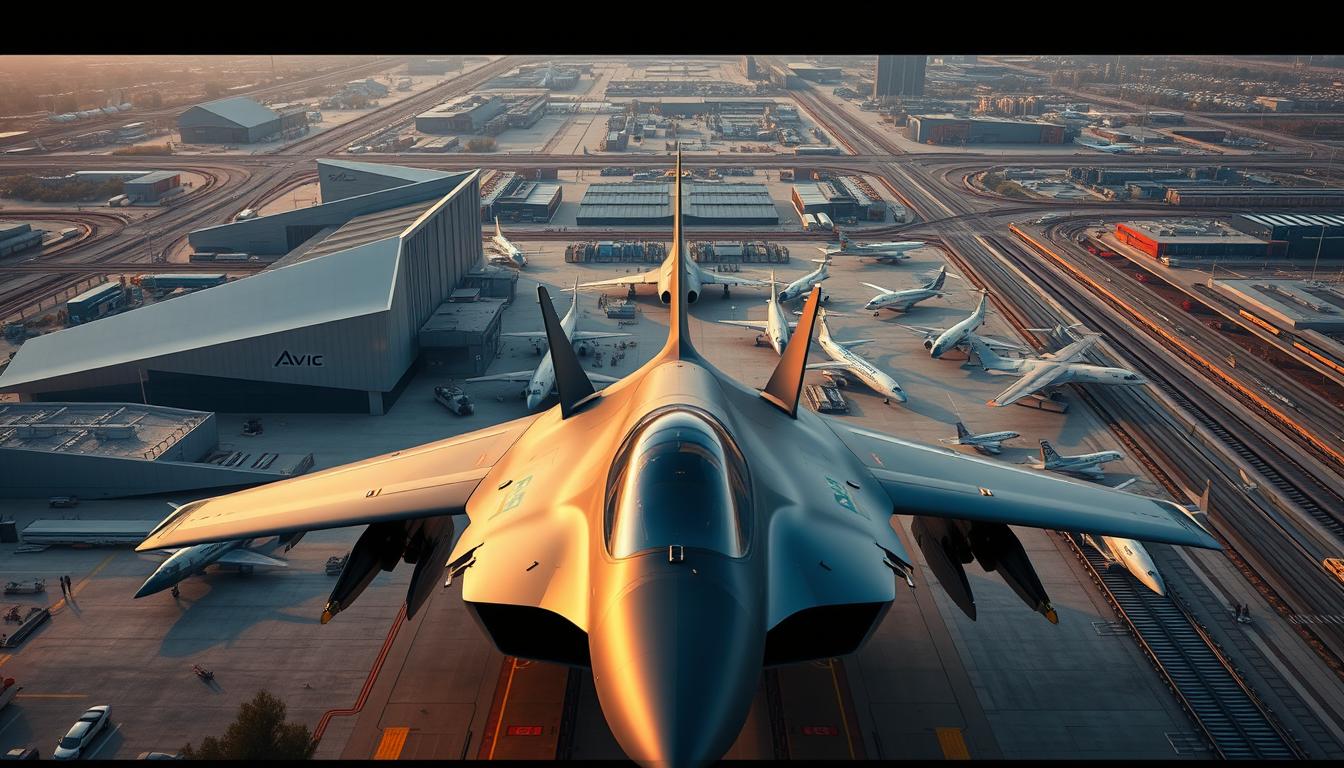
Key Business Units and Their Specializations
AVIC’s main units cover fighter aircraft, avionics, and maintenance. For example, AVIC Aircraft Corporation works on the JF-17 Thunder fighter jet. This is a big deal for China’s defense.
Other units work on unmanned aerial vehicles (UAVs) and advanced avionics. These areas boost AVIC’s skills at home and worldwide in the avic aerospace industry.
International Partnerships and Joint Ventures
AVIC has made many international partnerships and joint ventures. These moves help it grow globally. They are key for getting new tech and staying competitive worldwide.
For instance, AVIC teamed up with other companies to make aircraft parts and systems. These international partnerships are essential for the chinese defense industry. They help share tech and encourage local innovation.
Through these partnerships, AVIC gains global know-how. It also boosts its production and market share in the aerospace field.
China’s Military Aircraft Development Programs
China’s military aircraft development is changing its aviation industry and boosting its military strength. These efforts cover a wide range of planes, including fighter jets, transport planes, bombers, and drones.
Fighter Aircraft Programs
China has made big steps in fighter aircraft development. The Chengdu J-20 and Shenyang FC-31 are fifth-generation fighter jets that have caught the world’s eye. They come with advanced technology, stealth features, and powerful weapons.
These fighter jets show China’s growing skills in military aviation tech. The J-20, in particular, has sparked a lot of interest worldwide, with people watching its performance closely.
Transport and Bomber Aircraft
China is also improving its transport and bomber planes. The Xi’an Y-20 is a strategic transport plane that has boosted China’s military logistics. It can carry a lot of cargo and people over long distances, expanding China’s military reach.
China’s bomber plane development has also seen progress. The Xian H-6K is a new version of the H-6 bomber. It has better technology and can fly farther than older models, making it a strong part of China’s bomber fleet.
Unmanned Aerial Vehicles and Future Projects
Unmanned Aerial Vehicles (UAVs) are key in China’s military aircraft development. The CH-4 Rainbow and Wing Loong series show China’s UAV tech advancements. These drones are used for spying and attacks, giving China a flexible tool for military tasks.
Looking ahead, China plans to keep investing in its military aircraft programs. New technologies like hypersonic flight and advanced materials will likely shape the next generation of Chinese military planes.
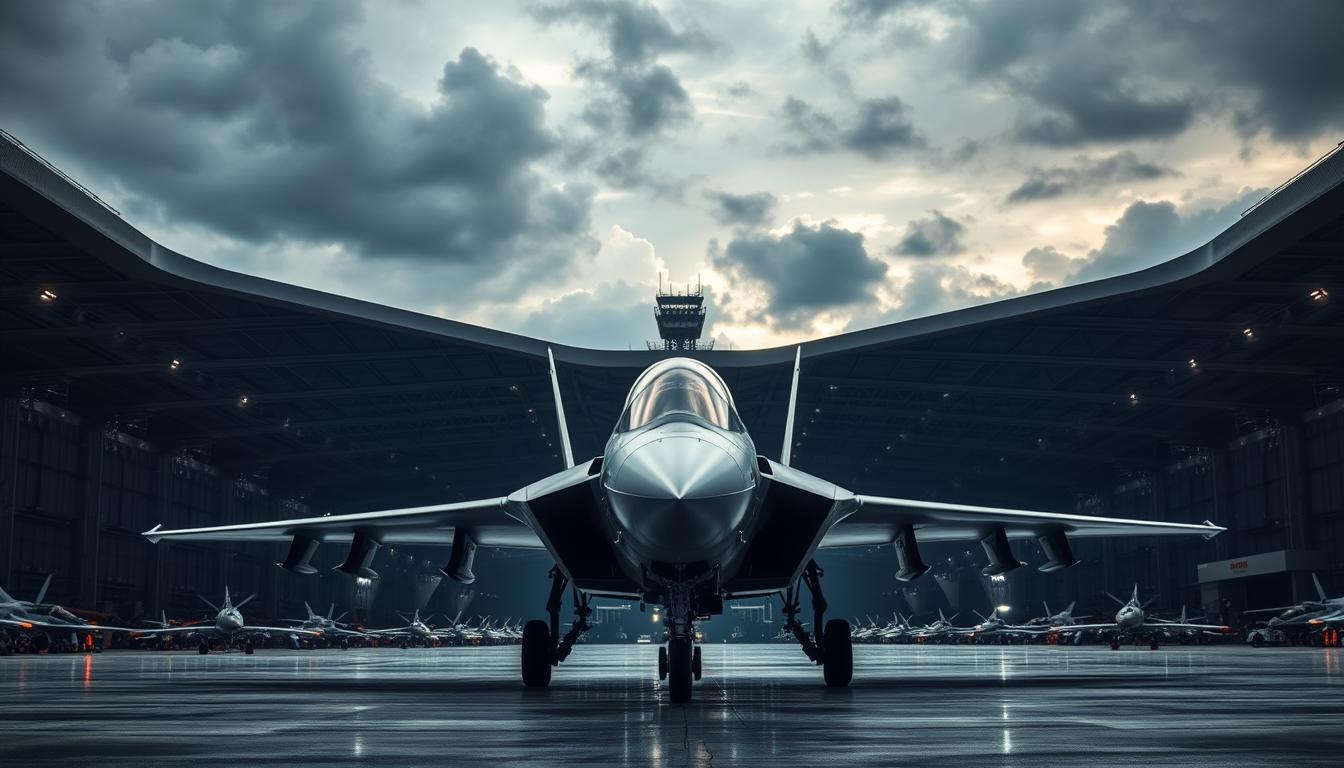
| Aircraft Type | Model | Capabilities |
|---|---|---|
| Fighter Aircraft | Chengdu J-20 | Advanced avionics, stealth capabilities |
| Transport Aircraft | Xi’an Y-20 | Long-range transport, large cargo capacity |
| Bomber Aircraft | Xian H-6K | Advanced avionics, longer range |
| Unmanned Aerial Vehicle | CH-4 Rainbow | Reconnaissance and strike capabilities |
Comparing AVIC with Western Aerospace Giants
The global military aviation market is changing fast. AVIC is now a big player, challenging Western aerospace leaders. This change is making the market more competitive and driving new tech.
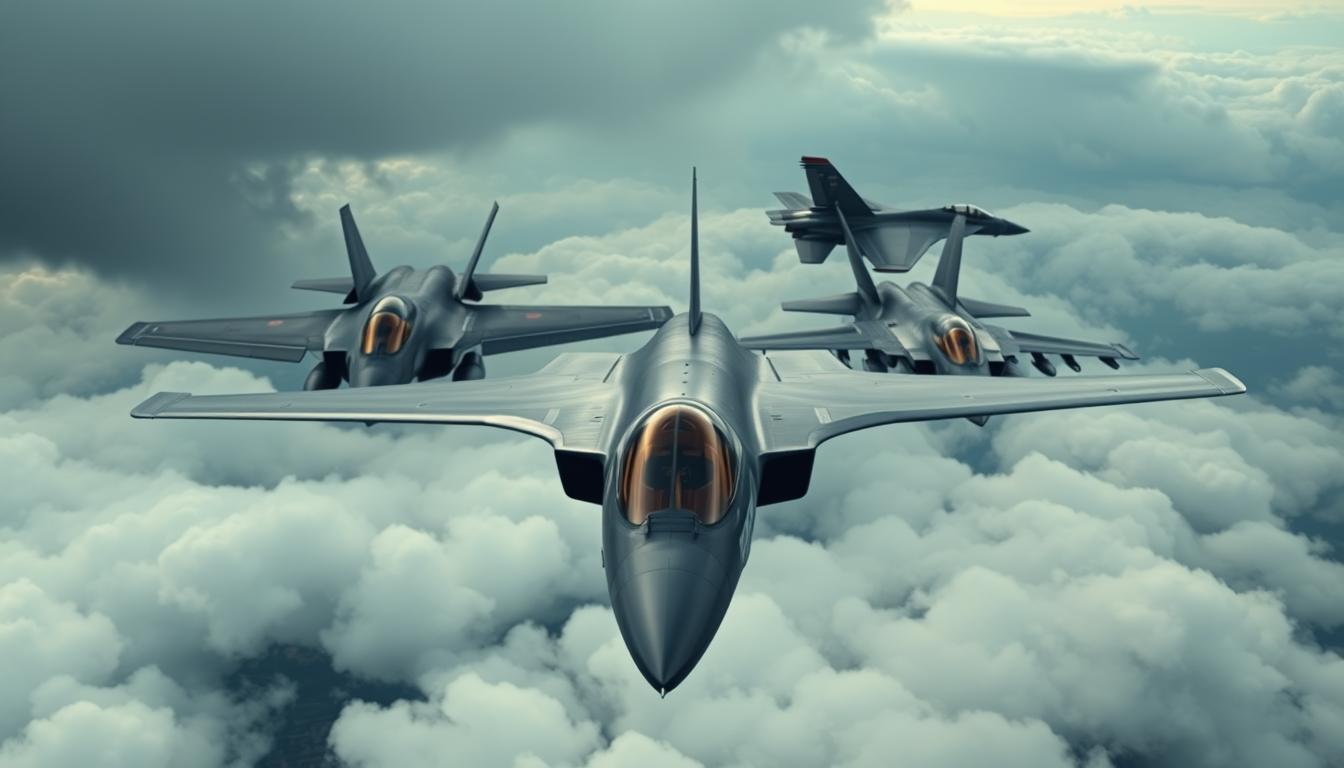
AVIC vs. Lockheed Martin
AVIC and Lockheed Martin are top names in aerospace defense. Lockheed Martin is famous for the F-35 Lightning II and F-22 Raptor. AVIC, on the other hand, is making waves with the FC-31 Gyrfalcon and JF-17 Thunder.
This rivalry is pushing both sides to innovate. AVIC is focusing on affordable tech, while Lockheed Martin is exploring stealth.
AVIC vs. Boeing Defense
Boeing Defense is a big name, known for the F/A-18 Hornet and F-15 Eagle. AVIC’s low prices and tech advancements are challenging Boeing. In response, Boeing is improving its products and looking into new tech like drones.
AVIC vs. European Manufacturers
European companies like BAE Systems and Airbus Defence and Space are also big players. AVIC’s rise has made them team up more and invest in research. This competition is creating a fast-paced environment where innovation is essential.
The battle between AVIC and Western aerospace giants shows the market’s evolution. As AVIC grows and improves, it will keep challenging Western companies. This rivalry will likely lead to more tech advancements in aerospace defense, benefiting everyone.
Technology Transfer and Indigenous Innovation
The Chinese aviation sector, led by AVIC, is rapidly evolving. It’s doing this through strategic technology transfer and a push towards indigenous innovation. This approach has helped China become a significant player in the global military aviation market.
From Reverse Engineering to Original Design
China’s defense industry used to rely on reverse engineering foreign technologies. But AVIC has made big strides in moving to original design and development. This is seen in the JF-17 Thunder, a joint project with Pakistan that shows China’s growing ability to design and manufacture advanced fighter jets.
Key advancements include better avionics, materials science, and propulsion systems. AVIC has also invested a lot in research and development. This has helped the company go beyond just copying existing technologies.
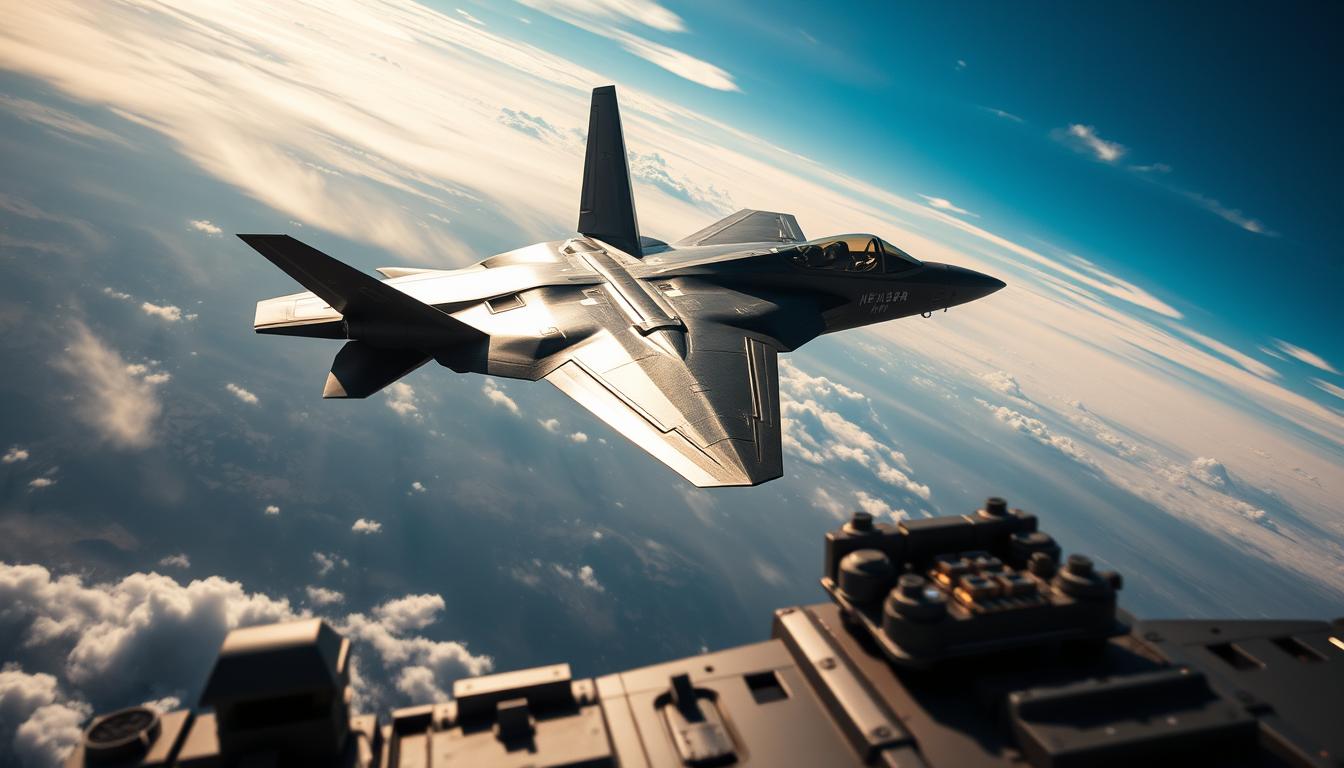
Civil-Military Integration in China’s Aviation Sector
Civil-military integration is key to China’s strategy for its aviation industry. By using technologies and innovations from the civil sector, AVIC has sped up its military aviation technology development. This integration has made it easier to use commercial off-the-shelf technologies, cutting down on development times and costs.
| Aspect | Description | Impact |
|---|---|---|
| Technology Transfer | Acquisition of foreign technologies through partnerships and investments | Enhanced indigenous capabilities |
| Indigenous Innovation | Development of original designs and technologies | Increased autonomy in defense production |
| Civil-Military Integration | Integration of civil technologies into military applications | Accelerated development and reduced costs |
The combination of technology transfer, indigenous innovation, and civil-military integration has made AVIC a strong competitor in the global aviation industry. As China keeps investing in its defense industry, AVIC’s role in shaping military aviation’s future will likely grow.
AVIC’s Export Strategy and International Markets
AVIC plays a big role in China’s military aviation plans. It aims to change the global military aviation scene. AVIC is growing its global reach through smart export moves.

AVIC’s plan to sell its aircraft is wide-ranging. It targets both well-known and new markets. It has made a mark in Southeast Asia, Africa, and Latin America. These areas need more military aviation options.
Key Export Markets for Chinese Military Aircraft
Some countries are big buyers of AVIC’s aircraft. Pakistan is a major customer, thanks to the JF-17 Thunder project. Other important buyers are Myanmar, Algeria, and Sri Lanka.
Chinese planes are appealing because they’re cheaper. China also offers flexible payment plans. This makes Chinese planes more appealing to countries seeking defense solutions.
Competitive Pricing and Financing Strategies
AVIC’s low prices help it sell more planes. China’s big production and lower labor costs make planes cheaper. This is a big advantage over Western makers.
AVIC also has better financing deals. Chinese banks help with these deals. This makes it easier for countries to buy planes.
In short, AVIC’s export plan is key to its growth. It focuses on low prices, flexible payments, and smart market entry. As the military aviation world changes, AVIC is ready to lead.
The Belt and Road Initiative’s Impact on AVIC’s Expansion
The Belt and Road Initiative (BRI) has become key for AVIC’s growth plans. It helps in building infrastructure and boosting international ties. This has opened up new chances for AVIC to grow in the global aviation market.
AVIC plays a big role in BRI, working on aviation projects and military ties. Its work in BRI countries shows its ability to expand globally.
Aviation Infrastructure Projects in BRI Countries
AVIC is busy with aviation projects in BRI countries. It’s building new airports, updating old ones, and improving air traffic systems.
Some examples of AVIC’s work include:
- Building a new airport in Nur-Sultan, Kazakhstan
- Updating airports in Sri Lanka, like the Colombo International Airport
- Working on the China-Pakistan Economic Corridor (CPEC), which includes aviation projects
These projects help AVIC grow globally and boost the economy of the countries involved.
| Country | Project | AVIC’s Role |
|---|---|---|
| Kazakhstan | Nur-Sultan New International Airport | Construction and development |
| Sri Lanka | Colombo International Airport modernization | Modernization and upgrade |
| Pakistan | CPEC Aviation Infrastructure Projects | Development and financing |
Military-Diplomatic Relations Through Aviation Cooperation
AVIC’s growth under BRI also includes strengthening military ties. It does this through joint exercises, technology sharing, and selling military planes. This helps AVIC build strong relationships with BRI countries.
“The Belt and Road Initiative is not just about infrastructure; it’s about creating a new era of cooperation and mutual benefit among participating nations.”
AVIC has sold military planes to countries like Pakistan and Myanmar. The JF-17 Thunder, made with Pakistan, shows AVIC’s success in military aviation cooperation under BRI.

The JF-17 Thunder has boosted Pakistan’s military and shown AVIC’s skill in working with international partners on complex projects.
As BRI grows, AVIC is ready to lead in aviation and military cooperation. Its ability to adapt and use BRI chances will be key to its global growth.
Technological Capabilities and Gaps
It’s key to know AVIC’s tech strengths and weaknesses in military aviation. AVIC has been pushing forward with tech, thanks to big investments in research and development.
Areas of Technological Advancement
AVIC has made big strides in military aviation tech. They’ve improved airframe design and materials to boost aircraft performance. They’ve also advanced in digital manufacturing and 3D printing, making production more efficient and cheaper.
Their work on unmanned aerial vehicles (UAVs) is impressive. They’ve developed autonomous systems and AI technologies. This makes AVIC a strong player in the global UAV market.
Persistent Challenges in Engine Development
Despite progress, AVIC faces big challenges in engine development. Creating high-performance, reliable engines is hard. They’ve had trouble with engine durability, efficiency, and thrust-to-weight ratios, which are key for military aircraft.
To tackle these issues, AVIC is pouring money into research and development. They’re also working with international partners to get advanced engine tech. But, the gap with Western engine tech is a worry.
Avionics and Stealth Technology Comparison
In avionics and stealth technology, AVIC has made good progress. They’ve developed advanced avionics, like sophisticated radar and electronic warfare systems. But, their systems might not be as advanced as Western ones.
Regarding stealth technology, AVIC has made big strides. Their stealth fighter jets, like the J-20 and J-31, show China’s growing stealth tech skills. Yet, when compared to Western stealth planes, like the F-35, AVIC has areas to improve. This includes radar-absorbent materials and design sophistication.
AVIC’s Role in China’s Military-Civil Fusion Strategy
AVIC leads in merging military and civilian tech, a key part of China’s defense plan. This strategy, called military-civil fusion, uses tech from one area to help the other. It boosts national security and tech skills.
Dual-Use Technologies and Applications
AVIC plays a big role in making dual-use technologies. These can be used for both military and civilian needs. For example, unmanned aerial vehicles (UAVs) help in military tasks and also in farming, disaster relief, and checking the environment.
AVIC works hard on research and development (R&D) with others. This teamwork speeds up new tech and makes sure it meets national needs.
| Technology | Military Application | Civilian Application |
|---|---|---|
| UAVs | Surveillance, Combat | Agriculture, Disaster Management |
| Advanced Materials | Stealth Technology, Armor | Aerospace Components, Automotive |
| Electronic Systems | C4ISR Systems | Telecommunications, Navigation |
Government Support and National Defense Priorities
The Chinese government backs AVIC’s work in military-civil fusion. They see it as key to boosting defense. The government helps with financial subsidies, tax breaks, and special policies for these techs.
“The military-civil fusion strategy is a cornerstone of China’s national defense policy, aiming to create a synergistic relationship between military and civilian sectors.”
AVIC’s work matches China’s defense goals. This is thanks to working closely with the government and the PLA. This ensures AVIC’s tech helps meet China’s strategic needs.
Case Studies: AVIC’s Major International Deals
AVIC’s deals show China’s growing role in global military aviation. These deals highlight AVIC’s skills and its plan to grow worldwide.
Pakistan’s JF-17 Thunder Program
The JF-17 Thunder is a big deal for AVIC, made with Pakistan. It’s a multi-role fighter aircraft key to Pakistan’s air force. It shows AVIC can work well with other countries.
The JF-17 program is known for successful technology transfer and co-production. Pakistan helps in making and upgrading the aircraft. This partnership boosts Pakistan’s aerospace and strengthens their defense ties.
| Program Aspect | Details | Impact |
|---|---|---|
| Development | Joint development with Pakistan | Enhanced bilateral defense cooperation |
| Production | Co-production in Pakistan | Boosted Pakistan’s aerospace industry |
| Capabilities | Multi-role fighter aircraft | Increased Pakistan’s air force capabilities |
Sales to African and Middle Eastern Nations
AVIC is selling to African and Middle Eastern countries. They use good prices and financing plans. AVIC offers solutions that fit these regions’ needs.
Nigeria and Algeria want Chinese military planes. They like the prices and the chance to learn from Chinese tech.
Southeast Asian Market Penetration
Southeast Asia is a big market for AVIC. Countries like Indonesia and Myanmar are looking at Chinese planes. AVIC is making local partnerships and custom defense products.
AVIC wants to sell more in Southeast Asia. This helps them not rely on just one area. It also makes the region’s defense more diverse.
Western Responses to China’s Aviation Market Expansion
As China grows in the global aviation market, Western countries are reacting. They worry about losing their tech lead and market share in aviation.
Export Controls and Technology Restrictions
Western nations are using export controls and tech restrictions on China. These steps aim to slow China’s aviation growth by limiting access to advanced tech.
The U.S. is leading these efforts, using the Export Administration Regulations (EAR) to block tech transfers to China. European countries also have their own export controls, but they vary in strictness.
Key Technologies Under Restriction
| Technology | Description | Reason for Restriction |
|---|---|---|
| Advanced Materials | High-strength, lightweight materials used in aircraft construction | Potential to enhance China’s military aviation capabilities |
| Cryptography and Cybersecurity | Technologies related to secure communication and data protection | Risk of compromising Western military communications |
| Aerospace-grade Electronics | High-performance electronics used in avionics and navigation systems | Could significantly improve China’s aviation technology |
Competitive Countermeasures by Western Manufacturers
Western aviation makers are fighting back with their own strategies. They’re investing in R&D to keep up with tech and providing financing to buyers.
They’re also strengthening ties with current customers and looking into new markets. This is key to staying competitive globally.
Geopolitical Implications of China’s Aviation Industry Growth
China’s aviation industry is changing the global balance of power. This growth has big effects on different regions and international relations.
Shifting Balance of Power in the Indo-Pacific
The Indo-Pacific region is seeing a big change in power balance. China’s growing aviation capabilities are changing the security dynamics. This could challenge the old powers’ dominance.
China’s aviation growth is boosting its military strength. It’s also changing the Indo-Pacific’s geopolitical landscape. This region is becoming more important in global politics, with China’s aviation playing a key role.
Impact on Military Alliances and Defense Cooperation
China’s aviation growth is also changing military alliances and defense cooperation. Countries in the Indo-Pacific are looking at their alliances and defense plans again. They’re doing this because of China’s growing aviation power.
This change is making nations rethink their defense priorities and partnerships. The impact on military alliances is big. Nations want to balance their ties with China and other global powers.
- There’s a rise in strengthening alliances and forming new defense partnerships.
- Nations are also working on improving their own aviation capabilities. This is to reduce their reliance on other countries.
China’s aviation growth has many geopolitical implications. It’s affecting regional power dynamics and international relations. It’s important for policymakers and those in the aviation and defense sectors to understand these implications.
Future Trajectories: AVIC’s Development Roadmap
AVIC’s future plans will shape the world of military aviation. As a major player in China’s defense industry, AVIC’s goals are key to understanding global power shifts.
Next-Generation Aircraft Projects
AVIC is working on next-generation aircraft projects to boost China’s military strength. They focus on:
- Advanced Fighter Jets: Developing jets with better stealth, avionics, and weapons.
- Unmanned Aerial Vehicles (UAVs): Creating advanced UAVs for military and civilian use.
Space and Missile Integration with Aviation
AVIC is also merging space and missile tech with aviation. This move could change military operations. Key projects include:
- Hypersonic Systems: Working on hypersonic systems to boost China’s military power.
- Satellite Technologies: Integrating satellite tech with aviation for better military coordination.
AVIC’s development roadmap is vital for China’s military upgrade. It has big implications for the global military aviation world. As AVIC grows its tech and global reach, knowing its future plans is key for all involved.
Challenges and Limitations Facing AVIC’s Global Ambitions
AVIC’s push to expand globally is facing many obstacles. The company aims to grow in the military aviation market. But, it must deal with technological hurdles and geopolitical resistance.
Technological Hurdles and Quality Control Issues
AVIC needs to bridge a big technological gap. It’s behind Western companies in key areas like jet engines and avionics.
A report by the US Congressional Research Service points out a big problem. “China’s military aviation industry has made progress, but it struggles with quality and reliability.” This shows AVIC must work on quality control to compete globally.
- Developing high-performance jet engines
- Advancing avionics and stealth technology
- Improving overall quality control
Geopolitical Resistance and Market Access Barriers
AVIC’s plans are also blocked by geopolitical resistance and market access barriers. Being a Chinese state-owned company, AVIC faces doubts from others. This is true in areas with tense politics.
“The rise of China’s military aviation industry poses a challenge to the existing global order, and Western countries are likely to respond with a mix of cooperation and competition.” – Analyst, Aerospace Review
This tension makes it hard for AVIC to get big deals. The company might try new ways, like joint ventures or special financing, to get past these hurdles.
| Challenge | Description | Impact |
|---|---|---|
| Technological Hurdles | Gaps in advanced technologies | Limited global competitiveness |
| Geopolitical Resistance | Skepticism from customers | Less market access |
Conclusion: The Changing Landscape of Global Military Aviation
The rise of AVIC is changing the global military aviation scene. It’s making a big impact on the China military aviation market and the wider defense aviation market. AVIC’s reach is growing, thanks to new military aircraft and partnerships around the world.
China’s aerospace industry is getting bigger, and AVIC is leading the change. The company’s strategy to sell its aircraft abroad is working. This makes Chinese planes a good choice for countries looking for alternatives to Western ones.
AVIC’s growth has big implications for the world of military aviation. It’s changing how power is balanced globally. For those in the defense aviation market, understanding AVIC’s role is key.
AVIC is set to be a major player in the future of military aviation worldwide. This brings both chances and challenges for the industry.
FAQ
▶
▶
▶
▶
▶
▶
▶
▶
▶
▶
▶
